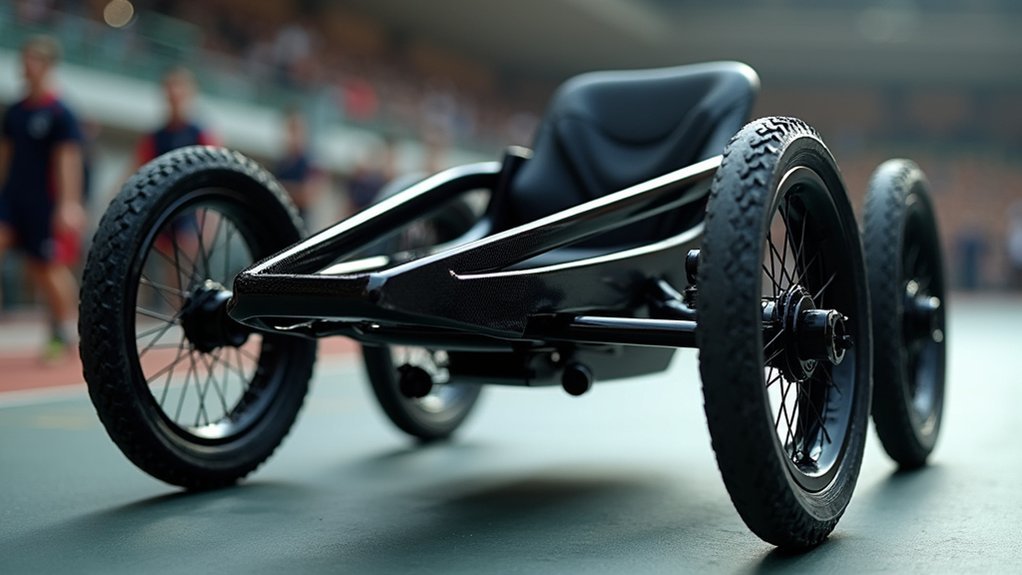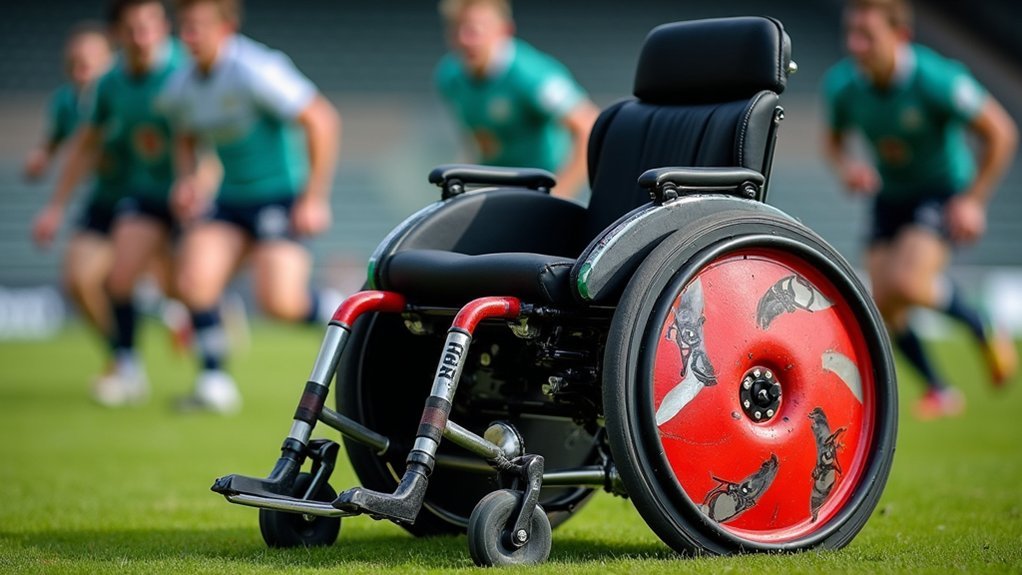When selecting a rugby wheelchair, focus on three critical specifications: a durable lightweight frame (aluminum or carbon fiber) with integrated protection, specialized wheel configuration tailored to your position (offensive or defensive setup), and custom seating solutions that optimize weight distribution for your body type. These specs directly impact your maneuverability, stability, and overall competitive performance. The right wheelchair customizations can transform your gameplay and give you a decisive edge on the court.
Wheelchair Frame Design and Durability Requirements

While standard wheelchairs prioritize comfort and mobility, rugby wheelchairs demand exceptional durability to withstand aggressive gameplay. Your wheelchair frame must be constructed from lightweight materials like aluminum or carbon fiber that balance strength with maneuverability during intense matches.
You’ll need front bumpers and side guards integrated into the design to protect your wheels during collisions and improve handling on the court.
Don’t overlook anti-tip devices—they’re vital for preventing dangerous overturns during aggressive plays.
Regular inspection of your wheelchair’s structural integrity isn’t optional but essential for both safety and performance.
Most players benefit from customization options, particularly adjustable seating positions that accommodate your unique body dimensions and playing style, ultimately enhancing your efficiency and effectiveness on the rugby court.
Wheel Configuration and Maneuverability Features
Unlike standard wheelchairs, rugby chairs feature a specialized wheel configuration that’s essential for competitive play.
You’ll find two larger rear wheels providing stability while two smaller front wheels enhance maneuverability during fast-paced gameplay. Offensive chairs include wings and bumpers designed to strike and hold opponents, while defensive models incorporate front-mounted pickers and elongated frames to block advancement.
- Strategic wheel placement – Proper configuration affects your turning radius and acceleration, critical when evading defenders or pursuing ball carriers.
- Custom seating solutions – Optimize your weight distribution for improved control and comfort during extended matches.
- Anti-tip devices – Prevent dangerous tipping during sharp turns or collisions without sacrificing your agility on court.
These features work together to create a chair that’s responsive to your playing style while maintaining necessary stability during intense competition.
Essential Protective Components and Customization Options

Because the sport demands intense physical contact, proper protective components on your rugby wheelchair aren’t optional—they’re crucial.
Front bumpers absorb the impact during collisions, protecting both you and your equipment during intense gameplay. Side guards shield your main wheels from damage while enhancing maneuverability on the court.
Custom seating solutions guarantee proper alignment, directly affecting your performance and injury prevention.
You’ll need to decide between offensive chairs designed for speed and agility or defensive chairs built for stability and control, depending on your playing style and position.
Regular maintenance keeps your equipment in top condition, while customization addresses your specific physical requirements and gameplay role.
These modifications aren’t just about equipment preferences—they’re strategic choices that can greatly influence your effectiveness in wheelchair rugby competitions.
Frequently Asked Questions
What Type of Wheelchair Would a Rugby Player Want to Use?
You’ll want a custom-made manual wheelchair designed for rugby’s physical demands. Choose offensive models for speed (0.5-1.5 point values) or defensive chairs with pickers for stability, depending on your playing style.
What Are the Requirements to Play Wheelchair Rugby?
You’ll need a disability affecting both upper and lower limbs, typically a spinal cord injury or condition like cerebral palsy. You’ll undergo classification to receive a point value between 0.5-3.5 for team composition.
What Is the Key Area for Wheelchair Rugby?
The key area in wheelchair rugby is a restricted zone near your opponent’s try line. You can’t stay there more than ten seconds to prevent stalling. It’s shaped like a basketball key for consistency.
What Is a 3.5 in Wheelchair Rugby?
In wheelchair rugby, a 3.5 classification means you have moderate functional impairment. You’ll contribute to offense and defense while counting toward your team’s maximum 8-point total for the four players on court.
In Summary
Your rugby wheelchair’s specs are critical to your success on the court. Choose a frame designed for impact resistance, wheels configured for quick turns and accelerations, and protective components tailored to your playing style. When you’re investing in this equipment, don’t compromise on quality or customization. Remember, the right chair isn’t just equipment—it’s your competitive advantage in this demanding sport.





Leave a Reply